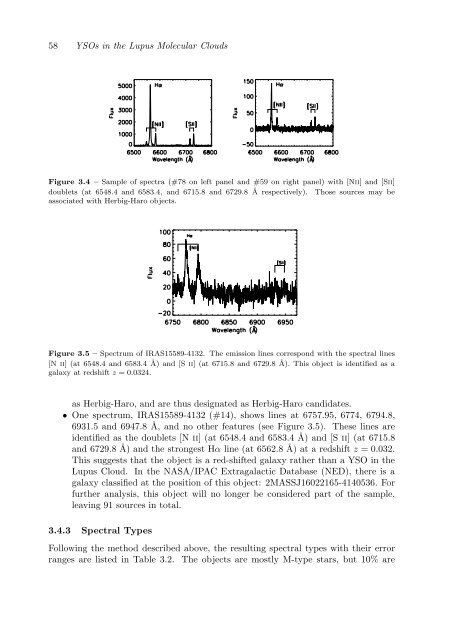Observational Constraints on The Evolution of Dust in ...
Observational Constraints on The Evolution of Dust in ...
Observational Constraints on The Evolution of Dust in ...
Create successful ePaper yourself
Turn your PDF publications into a flip-book with our unique Google optimized e-Paper software.
58 YSOs <strong>in</strong> the Lupus Molecular Clouds<br />
Figure 3.4 – Sample <strong>of</strong> spectra (#78 <strong>on</strong> left panel and #59 <strong>on</strong> right panel) with [Nii] and [Sii]<br />
doublets (at 6548.4 and 6583.4, and 6715.8 and 6729.8 Å respectively). Those sources may be<br />
associated with Herbig-Haro objects.<br />
Figure 3.5 – Spectrum <strong>of</strong> IRAS15589-4132. <strong>The</strong> emissi<strong>on</strong> l<strong>in</strong>es corresp<strong>on</strong>d with the spectral l<strong>in</strong>es<br />
[N ii] (at 6548.4 and 6583.4 Å) and [S ii] (at 6715.8 and 6729.8 Å). This object is identified as a<br />
galaxy at redshift z = 0.0324.<br />
as Herbig-Haro, and are thus designated as Herbig-Haro candidates.<br />
• One spectrum, IRAS15589-4132 (#14), shows l<strong>in</strong>es at 6757.95, 6774, 6794.8,<br />
6931.5 and 6947.8 Å, and no other features (see Figure 3.5). <strong>The</strong>se l<strong>in</strong>es are<br />
identified as the doublets [N ii] (at 6548.4 and 6583.4 Å) and [S ii] (at 6715.8<br />
and 6729.8 Å) and the str<strong>on</strong>gest Hα l<strong>in</strong>e (at 6562.8 Å) at a redshift z = 0.032.<br />
This suggests that the object is a red-shifted galaxy rather than a YSO <strong>in</strong> the<br />
Lupus Cloud. In the NASA/IPAC Extragalactic Database (NED), there is a<br />
galaxy classified at the positi<strong>on</strong> <strong>of</strong> this object: 2MASSJ16022165-4140536. For<br />
further analysis, this object will no l<strong>on</strong>ger be c<strong>on</strong>sidered part <strong>of</strong> the sample,<br />
leav<strong>in</strong>g 91 sources <strong>in</strong> total.<br />
3.4.3 Spectral Types<br />
Follow<strong>in</strong>g the method described above, the result<strong>in</strong>g spectral types with their error<br />
ranges are listed <strong>in</strong> Table 3.2. <strong>The</strong> objects are mostly M-type stars, but 10% are
















